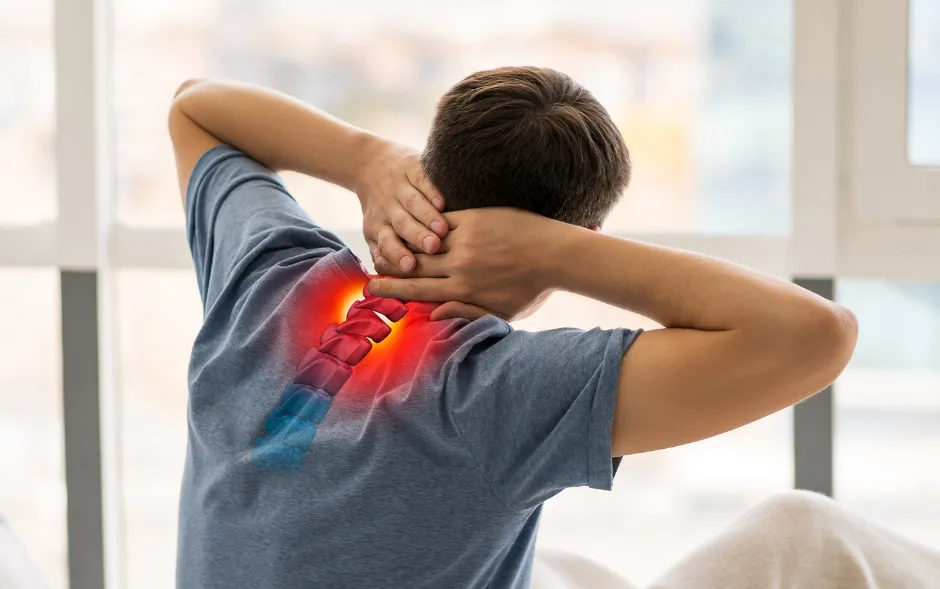Cervical disc herniation is a condition that affects the discs in your neck. This causes discomfort and can easily disrupt daily life. If you’ve been recently diagnosed or are exploring symptoms, don’t worry: we put everything you should know about cervical disc herniation below.
What Is Cervical Disc Herniation?
Your spine is made up of bones known as vertebrae, and these are cushioned by discs in between each that act like cushions. These discs are made up of a soft, gel-like center called the nucleus pulposus and a tough outer layer known as the annulus fibrosus. In a healthy spine, these discs absorb shock and allow for flexibility with ease.
Cervical disc herniation occurs when the gel-like center of a disc in the cervical spine (the neck region) pushes through the outer layer. This protrusion can irritate nearby nerves, leading to symptoms such as neck pain, tingling, numbness, or even weakness in the shoulders, arms, and hands.
Symptoms You Shouldn’t Ignore
Cervical disc herniation can manifest in various ways, depending on the severity of the herniation and which nerves are affected. Many people experience a persistent ache or sharp pain in the neck that radiates down into the arms. Others notice numbness or tingling sensations, making tasks like typing or holding objects more challenging.
In severe cases, herniation may compress the spinal cord, leading to more serious symptoms such as difficulty walking, loss of coordination, or even bowel and bladder issues. If you notice these more advanced symptoms, it’s best to seek medical attention immediately.
Why Does Cervical Disc Herniation Happen?
Cervical disc herniation is often the result of a combination of factors such as the following:
Natural Aging
Over time, the discs in your spine naturally lose some of their water content and elasticity. This makes them less able to absorb shocks and more susceptible to wear and tear. As the discs weaken, they can crack or rupture under stress, leading to herniation.
Injury or Trauma
Sudden impacts, such as those from car accidents or sports injuries, can put immense pressure on the neck, causing a disc to herniate. Even minor trauma, like an awkward fall, can trigger herniation if the disc is already compromised.
Repetitive Strain
Daily habits can also contribute to cervical disc herniation. Poor posture, particularly from prolonged use of computers or smartphones, puts added strain on the neck. Repeatedly tilting your head forward creates extra pressure on the cervical spine, increasing the risk of injury.
Genetic Predisposition
Some people may be more prone to cervical disc herniation due to genetic factors. If family members have experienced herniated discs, you might have a higher likelihood of developing the condition.
Lifestyle Factors
Smoking, obesity, and lack of exercise can all weaken spinal discs and muscles, making them more prone to injury. Smoking, in particular, reduces blood flow to the discs, impairing their ability to heal and maintain strength.
How Is Cervical Disc Herniation Diagnosed?
If you suspect cervical disc herniation, consulting a healthcare professional is the first step. A doctor will begin with a detailed medical history and physical examination to assess your symptoms. They may also perform simple tests to check reflexes, muscle strength, and sensation in your arms and hands.
Imaging studies, such as X-rays, MRIs, or CT scans, are often used to confirm the diagnosis. These scans provide a clear view of the spine, which allows doctors to see the herniation and determine its impact on surrounding nerves or the spinal cord.
Treatment Options for Cervical Disc Herniation
Fortunately, many cases of cervical disc herniation improve with conservative treatments. Rest, physical therapy, and anti-inflammatory medications are the best—and therefore often the first—line of defense.
Non-Surgical Approaches
Physical therapy can help strengthen neck and shoulder muscles, improving posture and reducing strain on the affected area. Heat and cold therapy, gentle stretching exercises, and over-the-counter pain relievers can also provide relief.
For more persistent symptoms, doctors may recommend corticosteroid injections to reduce inflammation and alleviate pain. These injections are typically performed under imaging guidance to target the exact location of the herniation.
Need for Surgery
In cases where symptoms persist despite conservative measures or when the spinal cord is compressed, surgical intervention may be required. Procedures like discectomy (removal of the herniated portion of the disc) or spinal fusion can relieve pressure on nerves and stabilize the spine.
If you believe one of your cervical discs has herniated, come see our team at Arkansas Spine and Pain right away. We’ll get right to work discovering what’s causing you pain to provide treatment options that fit you and your lifestyle. Contact us today for more information!

